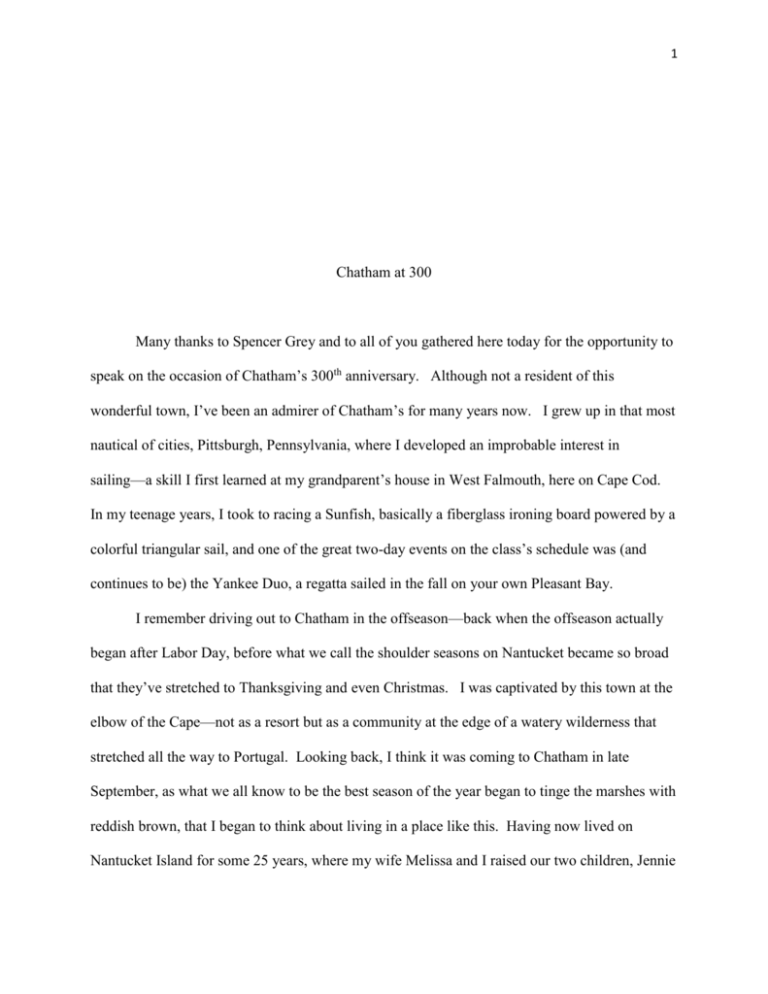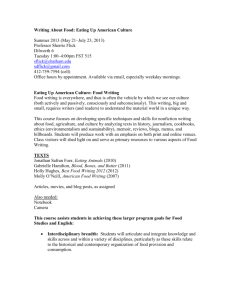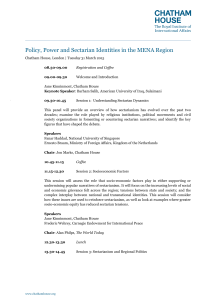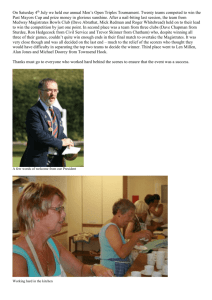Chatham at 300 Many thanks to Spencer Grey and to all of you
advertisement

1 Chatham at 300 Many thanks to Spencer Grey and to all of you gathered here today for the opportunity to speak on the occasion of Chatham’s 300th anniversary. Although not a resident of this wonderful town, I’ve been an admirer of Chatham’s for many years now. I grew up in that most nautical of cities, Pittsburgh, Pennsylvania, where I developed an improbable interest in sailing—a skill I first learned at my grandparent’s house in West Falmouth, here on Cape Cod. In my teenage years, I took to racing a Sunfish, basically a fiberglass ironing board powered by a colorful triangular sail, and one of the great two-day events on the class’s schedule was (and continues to be) the Yankee Duo, a regatta sailed in the fall on your own Pleasant Bay. I remember driving out to Chatham in the offseason—back when the offseason actually began after Labor Day, before what we call the shoulder seasons on Nantucket became so broad that they’ve stretched to Thanksgiving and even Christmas. I was captivated by this town at the elbow of the Cape—not as a resort but as a community at the edge of a watery wilderness that stretched all the way to Portugal. Looking back, I think it was coming to Chatham in late September, as what we all know to be the best season of the year began to tinge the marshes with reddish brown, that I began to think about living in a place like this. Having now lived on Nantucket Island for some 25 years, where my wife Melissa and I raised our two children, Jennie 2 and Ethan, I want to take this opportunity to thank the residents of Chatham for first showing me that year-round life in a town surrounded by the sea was not just possible but, just perhaps, my destiny. So, thank you, Chatham. In Herman Melville’s Moby-Dick, the narrator Ishmael begins his magical chapter about my island home, Nantucket, with a phrase that I’d like to quote today. He says, “Take out your map and look at it. See what a real corner of the world it occupies!” If ever there was a town situated at “a real corner of the world,” it is Chatham. This is the pivot point upon which the arm of Cape Cod goes from west to east to south to north. This is where the spit of Monomoy reaches toward Nantucket’s Great Point, and where Nauset Beach reaches down from Orleans and beyond. Thanks to these two sheltering stretches of sand, Chatham is surrounded by a complicated series of amoeba-shaped inlets: Stage Harbor, Oyster Pond, and Mill Pond to the south and Crow’s Pond, Ryder Cove, and the inland sea of Pleasant Bay to the north. Within the intricate convolutions of Chatham, people have thrived for not just hundreds but thousands of years. This is where the Nausets, Monomoyicks, and, later, the descendants of the Pilgrims flourished on fish and shellfish, corn and beans. Indeed, there is a wonderful sense of intimacy about the inlet-surrounded lobes of Chatham that transcends any one time or culture. But move just a few miles offshore, and you encounter an altogether different environment. For, as you all know, Chatham is poised on the edge of one of the most dangerous stretches of shoal water in the world. A huge volume of sea water passes in and out of Nantucket Sound two times every day, squeezing itself around Monomy into Pollock Rip with a ferocity that makes the waters off Chatham the literal graveyard of the Atlantic. I’d like to talk a little bit today about a narrowly 3 averted shipwreck that changed not just New England but the world. Because Chatham is much more than a town at the figurative crossroads of Cape Cod; it is truly at the crossroads of history. On Thursday, November 9, 1620, after 65 days at sea, the crew and 102 passengers of the battered old merchant ship called the Mayflower saw land. It was a beautiful, late-fall morning—clear skies and light winds out of the northwest. There was a thin slice of moon overhead, gradually fading to nothingness as the sun rose behind them in the east. Up ahead to the west was what Master Christopher Jones believed to be Cape Cod—what subsequent generations of mariners called the “back side” of the Cape. This almost 30 mile stretch of barrier beach is edged by dramatic 100-foot-high cliffs of sand. Stretching behind the cliffs were rolling, tree-covered hills. Future governor of Plymouth Colony William Bradford recorded that he and his fellow passengers were “not a little joyful…., and much comforted… [by] seeing so goodly a land, and wooded to the brink of the sea.” This was all well and good, but the people we refer to today as the Pilgrims were more than 200 miles off course. Their intended destination was near the mouth of the Hudson River, so Master Jones turned his ship south and started sailing along the edge of Cape Cod. Unfortunately, there was no reliable English chart of the waters between the Cape and the Hudson River. For all intents and purposes, Master Jones was sailing blind. As one of his crewmen checked the depth of the water with what was known as a deepsea or “dipsy” lead, Master Jones kept the Mayflower within a couple of miles of the beach, where the depth hovers at about 120 feet. For the next five hours, they slipped easily along. After 65 days of headwinds and storms, it must have been a wonderful respite for the passengers, who crowded the chilly, sun-drenched deck to drink in their first view of the New World. But for Master Jones, it was the beginning of the most tension-filled portion of the passage. 4 He stood perched on the aftmost deck of his ship—a narrow, razorback ridge of planking called the poop deck. Here, two and a half stories up, with the expansive girth of the Mayflower—20 or so feet at her widest—before him, Jones stared out nervously toward the shore to starboard, awaiting the latest word on the sea’s depth. They sailed south on an easy reach, past the future locations of Wellfleet, Eastham, Orleans, and, of course, Chatham. Throughout the morning the tide was with them, but around 1 p.m. it began to flow the other way. Then the depth of the water dropped alarmingly, as did the wind. Suddenly, without warning, the Mayflower had stumbled into the frightening maze of shoals called Pollock Rip. Fourteen years before, in 1606, the French explorer Samuel Champlain attempted to navigate these waters in a small pinnace. It was Champlain’s second visit to the Cape, and even though he took every precaution, his vessel fetched upon a shoal and was almost pounded to pieces before he managed to float her free and sail into Nantucket Sound. Champlain’s pinnace drew four feet; the deeply laden Mayflower drew twelve. The placid heave of the sea had been transformed into a churning maelstrom as the outflowing tide cascaded over the shoals ahead. With the wind dying to nothing, Jones had no way to extricate his ship. “They fell amongst dangerous shoals and roaring breakers,” Bradford wrote, “and they were so far entangled therewith as they conceived themselves in great danger.” It was 3 p.m. with only another hour and half of daylight left. Just when it seemed they might never live to see dry land again, the wind began to freshen from the south. This, combined with a fair tide, was all Master Jones needed. By sunset at 4:35 p.m., the Mayflower was well to the northwest of Pollock Rip. 5 With the wind building from the south, Jones made a momentous decision. They weren’t going to the Hudson River. They were going back around Cape Cod to what we call today Provincetown Harbor. To that one fateful decision, whereby what came to be called Plymouth Plantation moved from New York to New England, depends so much of this region’s and this country’s history. And it all happened in the turbulent waters off Chatham. Just as significant is what occurred that evening as the Mayflower lay with her main topsail aback—hove to, in the parlance of the sea. Master Jones had decided to wait for daylight before he continued north along this unknown coast. As the Mayflower lay there, hardly moving, her passengers were in an uproar. The news that they were not going to the Hudson River had changed everything. Their patent from the King did not apply to a settlement this far north. Some of the passengers—those who did not share the Pilgrims’ Separatist religious beliefs— claimed that this meant all bets were off. When they got ashore, they would “use their own liberty for none had power to command them” and form their own settlement. This, of course, would have been a disaster. They were bound for a place about which they knew essentially nothing. It was almost winter. Some of them were sick and two had already died. If they fractured into two different squabbling settlements, it was highly unlikely that any of them were going to see the spring. So they did an extraordinary thing. They put pen to paper and wrote what is known today as the Mayflower Compact—an agreement by which all of them agreed to submit to the laws enacted by their duly elected civil officials. Given the circumstances under which it was written—on a ship crowded with some very tense and fearful people at what they considered to be the edge of the universe—the compact is a surprisingly eloquent document, and this is how at least a portion of it goes: 6 “Having undertaken, for the glory of God and advancement of the Christian faith and honor of our King and country, a voyage to plant the first colony in the northern parts of Virginia, do these present solemnly and mutually in the presence of God and one another, covenant and combine ourselves together in a civil body politic, for our better ordering and perseveration.” Now this is not the U.S. constitution in utero. The Mayflower Compact did not invent a way of government that was any different from any town back in England. What made the document truly remarkable was that it applied to a group of people who were 3,000 miles from home. The physical reality of all that space—and all the terror, freedom, and insularity it fostered—informed everything that occurred in the days and years ahead. There is a lesser known event that is perhaps of even more significance when it comes to Chatham’s connection with the Pilgrims. We left the Mayflower bobbing off these shores in November 1620. Let’s fast forward two years to the fall of 1622; after nearly starving to death, the fledgling Pilgrim settlement in Plymouth Harbor was saved by the intervention of the Wampanoag sachem Massasoit, with whom the Pilgrims celebrated what we call today the First Thanksgiving in the fall of 1621. By the following year, the Pilgrims had run out of corn, and Bradford along with the native interpreter Squanto went on a trading mission to provide the colony with much-needed grain. They departed on a small sailing vessel called the Swan, and after rounding the tip of Cape Cod were headed for the same shoals that almost wrecked the Mayflower two years before. Squanto, however, knew these waters. He’d sailed them two times before with an English explorer named Dermer. Squanto, it turns out, was a man of incredibly varied experience. More than a decade before he’d been abducted by English explorers associated with 7 Captain John Smith and spent several years in London, where he’d learned the Englishmen’s language. He later made his way to Newfoundland, and in 1619 he was in a boat with Dermer making his way down the New England coast to his home of Patuxet, today’s Plymouth Harbor. Instead of being greeted by his family and friends, Squanto found desolation. “When we arrived at my savage’s native country,” Dermer wrote, “we found all dead.” Over the course of the last few years, a European-spawned epidemic had swept down the coast, killing in some instances 90 per cent of the inhabitants. This is the legacy of loss that can never be forgotten when we gather to memorialize what—at 300 years—is a mere blip in a human history that reaches back thousands upon thousands of years and will extend into the future for thousands upon thousands more, knock on wood. Instead of pride, humility, I think, is the best way to approach the past. It is also a good way for a navigator to negotiate the ever-shifting shoals surrounding Chatham, and in the fall of 1622, it was Squanto leading Governor Bradford to what was then known as Manamoyick. Once ashore, they began trading with a village that archeologists have determined was a couple of miles from here, ultimately securing, Bradford recorded, eight hogsheads of corn and beans until suddenly Squanto fell ill. Like so many of his countrymen who had died in the years before, he began bleeding from the nose, and within a few days Squanto had been buried, according to several accounts, somewhere to the north of where we are now. Bradford claimed Squanto asked him to “pray for him that he might go the Englishmen’s God in Heaven; and bequeathed sundry of his things to sundry of his England friends as remembrances of his love.” Whether or not Squanto was telling Bradford what he wanted to hear, I think it’s undeniable that there was a deep and very personal friendship between these two very different men. The scene of farewell that was enacted here almost 390 years ago speaks to the legacy of 8 accommodation—that unending search for a middle ground between the wildness of the ocean and the security of the shore—that is, at least for now, Chatham’s place on the map. Thank you. --Nathaniel Philbrick June 11, 2012







